International HRM: Global Challenges, Talent & Gender Considerations
VerifiedAdded on 2022/08/25
|8
|1619
|17
Report
AI Summary
This report addresses key aspects of International Human Resource Management (IHRM) within a globalized business environment. It examines the critical questions HR managers should consider when expanding operations internationally, emphasizing the importance of confidentiality, conflict resolution, and addressing discrimination. The report analyzes gender differences in international business travel, highlighting female travelers' concerns about safety and logistical preferences. It discusses global talent management strategies, focusing on attracting, selecting, developing, and retaining talented employees, while also tackling challenges like competition and employee engagement. Furthermore, it explores the responses IHRM must develop to meet globalization challenges, including compliance with laws, management of change, leadership development, and training initiatives. Finally, it delves into the complexities of managing a global employer brand, addressing issues such as cultural alignment, talent retention, and flexible work arrangements. This report is contributed by a student and available on Desklib, a platform offering study tools and resources for students.

Running head: INTERNATIONAL HUMAN RESOURCE MANAGEMENT
International Human Resource Management
Name of the Student:
Name of the University:
International Human Resource Management
Name of the Student:
Name of the University:
Paraphrase This Document
Need a fresh take? Get an instant paraphrase of this document with our AI Paraphraser
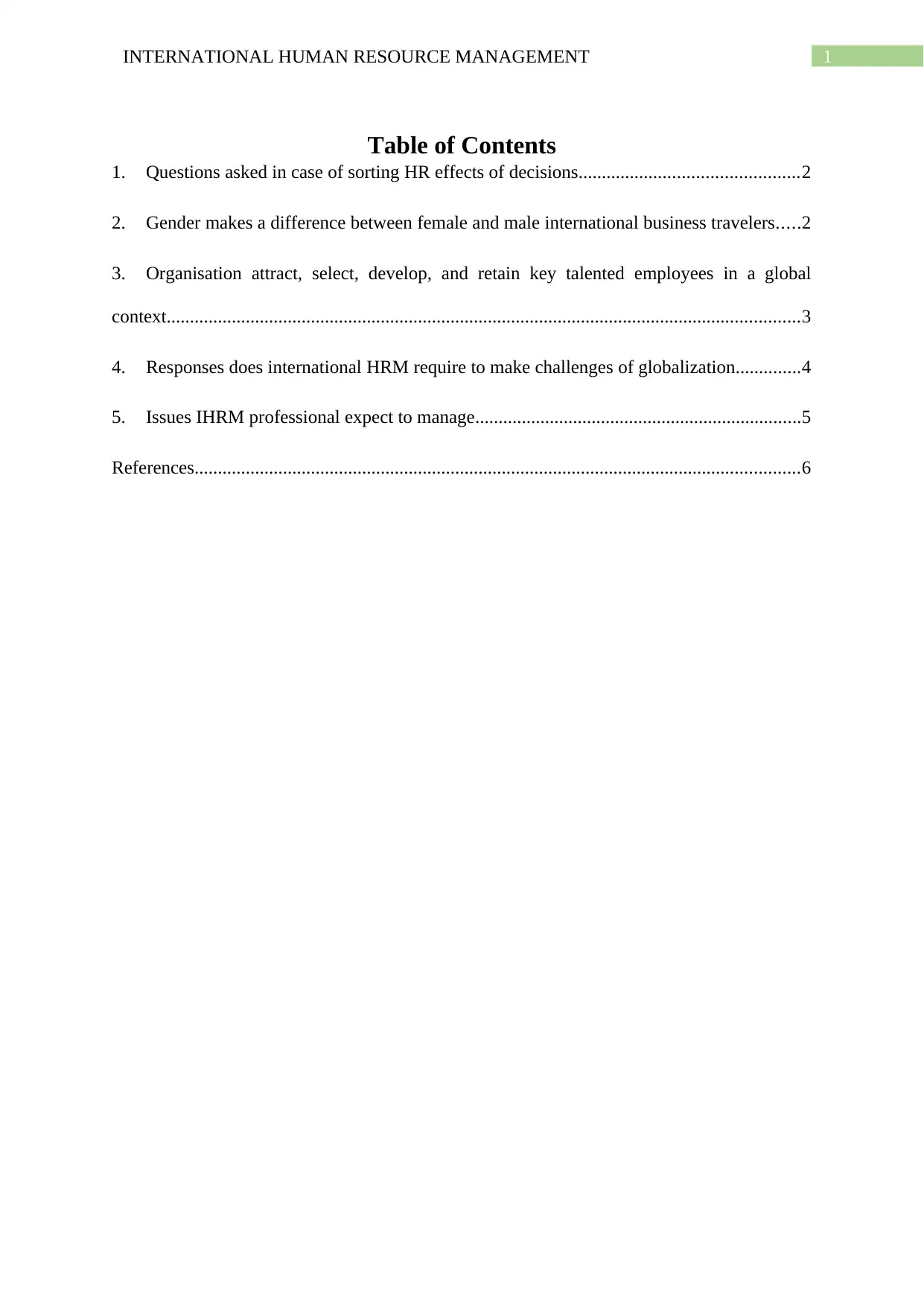
1INTERNATIONAL HUMAN RESOURCE MANAGEMENT
Table of Contents
1. Questions asked in case of sorting HR effects of decisions...............................................2
2. Gender makes a difference between female and male international business travelers.....2
3. Organisation attract, select, develop, and retain key talented employees in a global
context........................................................................................................................................3
4. Responses does international HRM require to make challenges of globalization..............4
5. Issues IHRM professional expect to manage......................................................................5
References..................................................................................................................................6
Table of Contents
1. Questions asked in case of sorting HR effects of decisions...............................................2
2. Gender makes a difference between female and male international business travelers.....2
3. Organisation attract, select, develop, and retain key talented employees in a global
context........................................................................................................................................3
4. Responses does international HRM require to make challenges of globalization..............4
5. Issues IHRM professional expect to manage......................................................................5
References..................................................................................................................................6
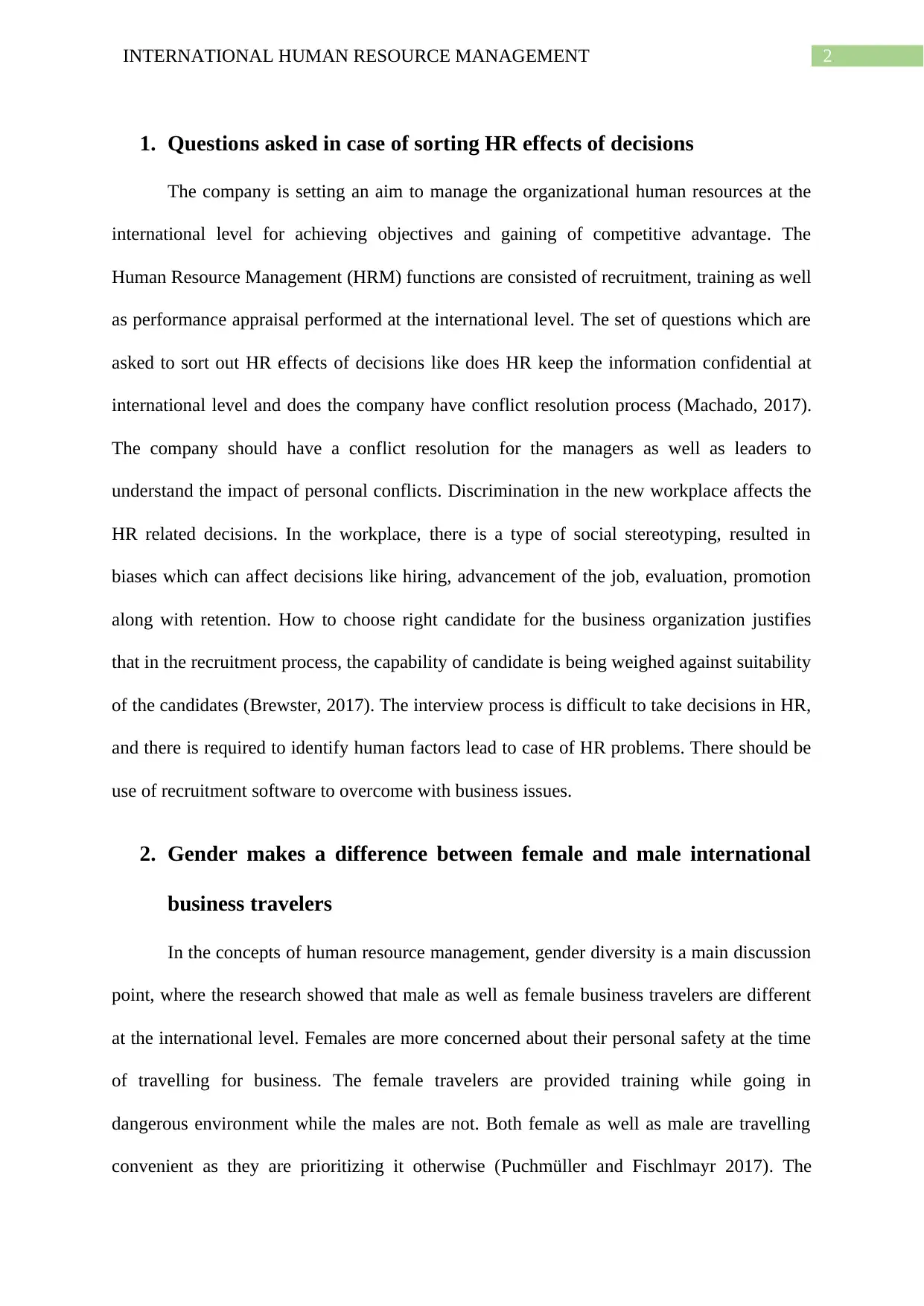
2INTERNATIONAL HUMAN RESOURCE MANAGEMENT
1. Questions asked in case of sorting HR effects of decisions
The company is setting an aim to manage the organizational human resources at the
international level for achieving objectives and gaining of competitive advantage. The
Human Resource Management (HRM) functions are consisted of recruitment, training as well
as performance appraisal performed at the international level. The set of questions which are
asked to sort out HR effects of decisions like does HR keep the information confidential at
international level and does the company have conflict resolution process (Machado, 2017).
The company should have a conflict resolution for the managers as well as leaders to
understand the impact of personal conflicts. Discrimination in the new workplace affects the
HR related decisions. In the workplace, there is a type of social stereotyping, resulted in
biases which can affect decisions like hiring, advancement of the job, evaluation, promotion
along with retention. How to choose right candidate for the business organization justifies
that in the recruitment process, the capability of candidate is being weighed against suitability
of the candidates (Brewster, 2017). The interview process is difficult to take decisions in HR,
and there is required to identify human factors lead to case of HR problems. There should be
use of recruitment software to overcome with business issues.
2. Gender makes a difference between female and male international
business travelers
In the concepts of human resource management, gender diversity is a main discussion
point, where the research showed that male as well as female business travelers are different
at the international level. Females are more concerned about their personal safety at the time
of travelling for business. The female travelers are provided training while going in
dangerous environment while the males are not. Both female as well as male are travelling
convenient as they are prioritizing it otherwise (Puchmüller and Fischlmayr 2017). The
1. Questions asked in case of sorting HR effects of decisions
The company is setting an aim to manage the organizational human resources at the
international level for achieving objectives and gaining of competitive advantage. The
Human Resource Management (HRM) functions are consisted of recruitment, training as well
as performance appraisal performed at the international level. The set of questions which are
asked to sort out HR effects of decisions like does HR keep the information confidential at
international level and does the company have conflict resolution process (Machado, 2017).
The company should have a conflict resolution for the managers as well as leaders to
understand the impact of personal conflicts. Discrimination in the new workplace affects the
HR related decisions. In the workplace, there is a type of social stereotyping, resulted in
biases which can affect decisions like hiring, advancement of the job, evaluation, promotion
along with retention. How to choose right candidate for the business organization justifies
that in the recruitment process, the capability of candidate is being weighed against suitability
of the candidates (Brewster, 2017). The interview process is difficult to take decisions in HR,
and there is required to identify human factors lead to case of HR problems. There should be
use of recruitment software to overcome with business issues.
2. Gender makes a difference between female and male international
business travelers
In the concepts of human resource management, gender diversity is a main discussion
point, where the research showed that male as well as female business travelers are different
at the international level. Females are more concerned about their personal safety at the time
of travelling for business. The female travelers are provided training while going in
dangerous environment while the males are not. Both female as well as male are travelling
convenient as they are prioritizing it otherwise (Puchmüller and Fischlmayr 2017). The
⊘ This is a preview!⊘
Do you want full access?
Subscribe today to unlock all pages.

Trusted by 1+ million students worldwide
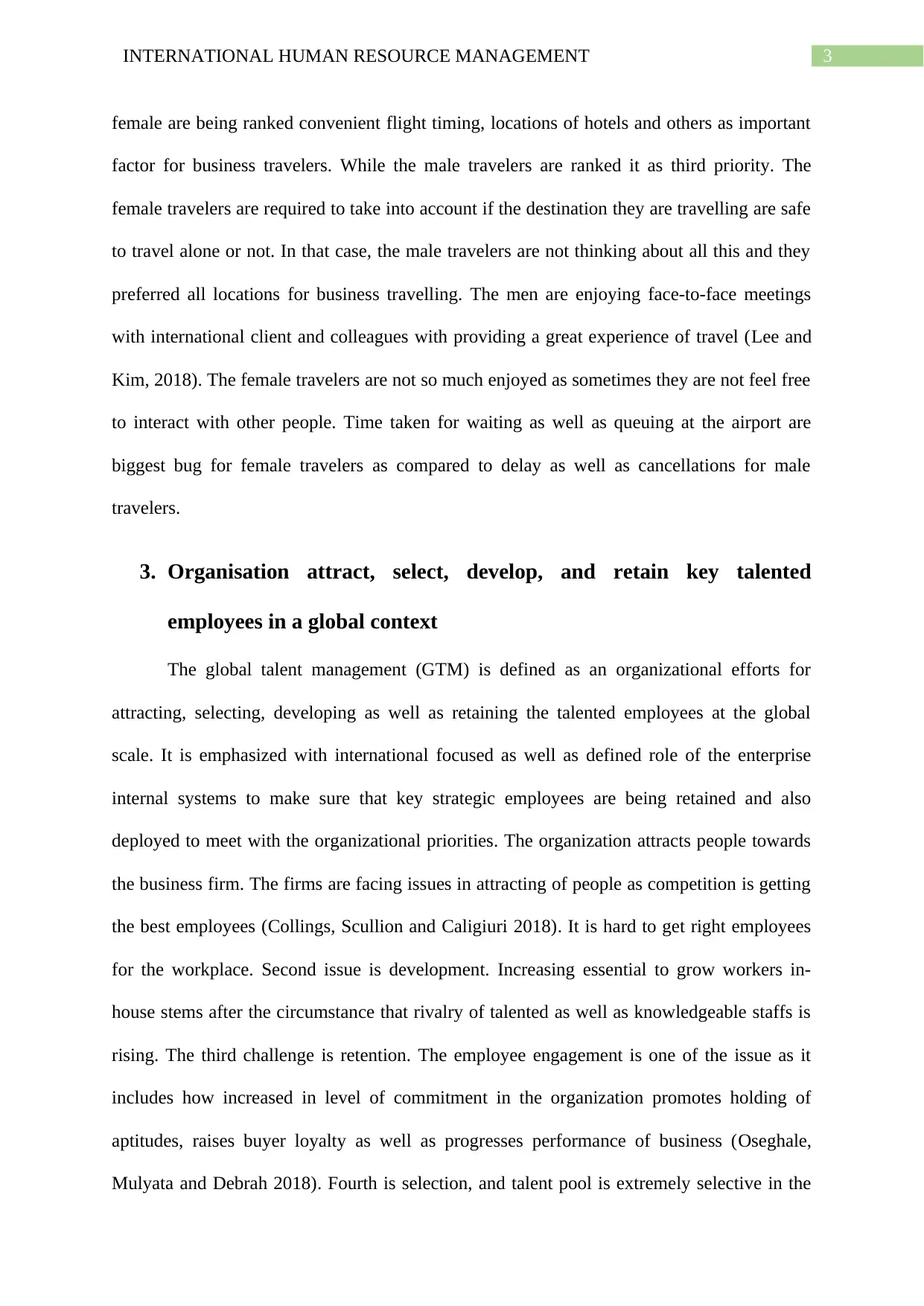
3INTERNATIONAL HUMAN RESOURCE MANAGEMENT
female are being ranked convenient flight timing, locations of hotels and others as important
factor for business travelers. While the male travelers are ranked it as third priority. The
female travelers are required to take into account if the destination they are travelling are safe
to travel alone or not. In that case, the male travelers are not thinking about all this and they
preferred all locations for business travelling. The men are enjoying face-to-face meetings
with international client and colleagues with providing a great experience of travel (Lee and
Kim, 2018). The female travelers are not so much enjoyed as sometimes they are not feel free
to interact with other people. Time taken for waiting as well as queuing at the airport are
biggest bug for female travelers as compared to delay as well as cancellations for male
travelers.
3. Organisation attract, select, develop, and retain key talented
employees in a global context
The global talent management (GTM) is defined as an organizational efforts for
attracting, selecting, developing as well as retaining the talented employees at the global
scale. It is emphasized with international focused as well as defined role of the enterprise
internal systems to make sure that key strategic employees are being retained and also
deployed to meet with the organizational priorities. The organization attracts people towards
the business firm. The firms are facing issues in attracting of people as competition is getting
the best employees (Collings, Scullion and Caligiuri 2018). It is hard to get right employees
for the workplace. Second issue is development. Increasing essential to grow workers in-
house stems after the circumstance that rivalry of talented as well as knowledgeable staffs is
rising. The third challenge is retention. The employee engagement is one of the issue as it
includes how increased in level of commitment in the organization promotes holding of
aptitudes, raises buyer loyalty as well as progresses performance of business (Oseghale,
Mulyata and Debrah 2018). Fourth is selection, and talent pool is extremely selective in the
female are being ranked convenient flight timing, locations of hotels and others as important
factor for business travelers. While the male travelers are ranked it as third priority. The
female travelers are required to take into account if the destination they are travelling are safe
to travel alone or not. In that case, the male travelers are not thinking about all this and they
preferred all locations for business travelling. The men are enjoying face-to-face meetings
with international client and colleagues with providing a great experience of travel (Lee and
Kim, 2018). The female travelers are not so much enjoyed as sometimes they are not feel free
to interact with other people. Time taken for waiting as well as queuing at the airport are
biggest bug for female travelers as compared to delay as well as cancellations for male
travelers.
3. Organisation attract, select, develop, and retain key talented
employees in a global context
The global talent management (GTM) is defined as an organizational efforts for
attracting, selecting, developing as well as retaining the talented employees at the global
scale. It is emphasized with international focused as well as defined role of the enterprise
internal systems to make sure that key strategic employees are being retained and also
deployed to meet with the organizational priorities. The organization attracts people towards
the business firm. The firms are facing issues in attracting of people as competition is getting
the best employees (Collings, Scullion and Caligiuri 2018). It is hard to get right employees
for the workplace. Second issue is development. Increasing essential to grow workers in-
house stems after the circumstance that rivalry of talented as well as knowledgeable staffs is
rising. The third challenge is retention. The employee engagement is one of the issue as it
includes how increased in level of commitment in the organization promotes holding of
aptitudes, raises buyer loyalty as well as progresses performance of business (Oseghale,
Mulyata and Debrah 2018). Fourth is selection, and talent pool is extremely selective in the
Paraphrase This Document
Need a fresh take? Get an instant paraphrase of this document with our AI Paraphraser
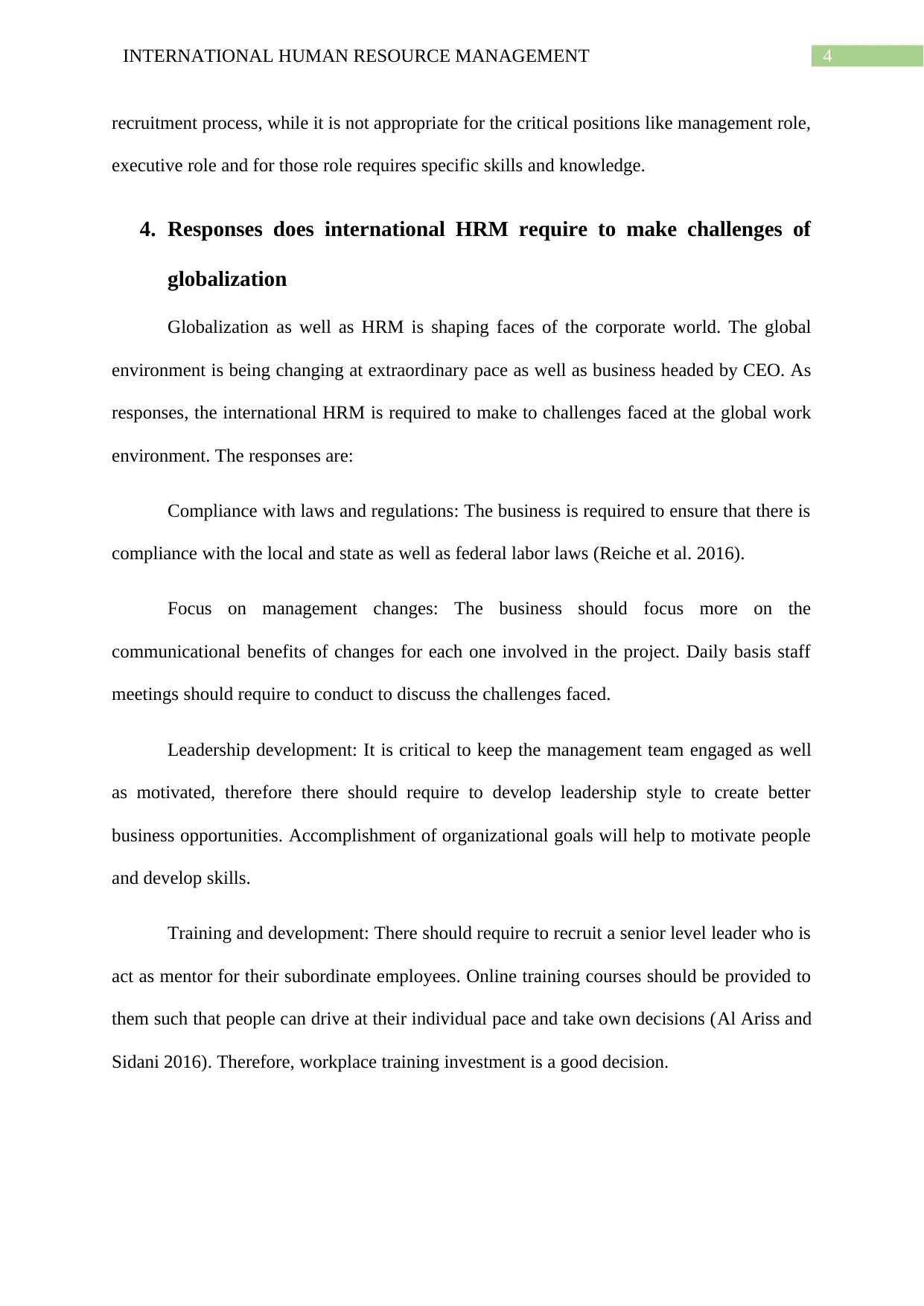
4INTERNATIONAL HUMAN RESOURCE MANAGEMENT
recruitment process, while it is not appropriate for the critical positions like management role,
executive role and for those role requires specific skills and knowledge.
4. Responses does international HRM require to make challenges of
globalization
Globalization as well as HRM is shaping faces of the corporate world. The global
environment is being changing at extraordinary pace as well as business headed by CEO. As
responses, the international HRM is required to make to challenges faced at the global work
environment. The responses are:
Compliance with laws and regulations: The business is required to ensure that there is
compliance with the local and state as well as federal labor laws (Reiche et al. 2016).
Focus on management changes: The business should focus more on the
communicational benefits of changes for each one involved in the project. Daily basis staff
meetings should require to conduct to discuss the challenges faced.
Leadership development: It is critical to keep the management team engaged as well
as motivated, therefore there should require to develop leadership style to create better
business opportunities. Accomplishment of organizational goals will help to motivate people
and develop skills.
Training and development: There should require to recruit a senior level leader who is
act as mentor for their subordinate employees. Online training courses should be provided to
them such that people can drive at their individual pace and take own decisions (Al Ariss and
Sidani 2016). Therefore, workplace training investment is a good decision.
recruitment process, while it is not appropriate for the critical positions like management role,
executive role and for those role requires specific skills and knowledge.
4. Responses does international HRM require to make challenges of
globalization
Globalization as well as HRM is shaping faces of the corporate world. The global
environment is being changing at extraordinary pace as well as business headed by CEO. As
responses, the international HRM is required to make to challenges faced at the global work
environment. The responses are:
Compliance with laws and regulations: The business is required to ensure that there is
compliance with the local and state as well as federal labor laws (Reiche et al. 2016).
Focus on management changes: The business should focus more on the
communicational benefits of changes for each one involved in the project. Daily basis staff
meetings should require to conduct to discuss the challenges faced.
Leadership development: It is critical to keep the management team engaged as well
as motivated, therefore there should require to develop leadership style to create better
business opportunities. Accomplishment of organizational goals will help to motivate people
and develop skills.
Training and development: There should require to recruit a senior level leader who is
act as mentor for their subordinate employees. Online training courses should be provided to
them such that people can drive at their individual pace and take own decisions (Al Ariss and
Sidani 2016). Therefore, workplace training investment is a good decision.

5INTERNATIONAL HUMAN RESOURCE MANAGEMENT
5. Issues IHRM professional expect to manage
The employee branding is focused on how employees are acting as per values of the
business organization and how the organization is promoting. In order to manage an
employer brand, it is required to develop strategy to reach the branding objectives. The
strategy is mainly developed based on understanding business requirements and identifying
the targets. A compelling employer brand message is being developed and delivered across
various platforms (Budhwar 2016). There is building of efficient career site, engagement on
the social media and job postings will help to manage the employer brand. The social media
is helpful to gain awareness of people.
The key issues faced by the IHRM professional while managing employer brand are
culture, talent brand and working flexibility. The market demands of the business work more
to make growth in the market and expand, while it affects the culture of business
organization. Sometimes, in the workplace, the talented candidates are not retained and
rewarded based on their performance, therefore it is identified as a market competitiveness. It
provides negative influence on loyalty among the employees (Domínguez 2016). Comping
generations of company’s employees are emphasized on working in flexible basis and the
concern is that it allows the individuals to work as they want to increase productivity, while
there are not paid as per their working hours.
5. Issues IHRM professional expect to manage
The employee branding is focused on how employees are acting as per values of the
business organization and how the organization is promoting. In order to manage an
employer brand, it is required to develop strategy to reach the branding objectives. The
strategy is mainly developed based on understanding business requirements and identifying
the targets. A compelling employer brand message is being developed and delivered across
various platforms (Budhwar 2016). There is building of efficient career site, engagement on
the social media and job postings will help to manage the employer brand. The social media
is helpful to gain awareness of people.
The key issues faced by the IHRM professional while managing employer brand are
culture, talent brand and working flexibility. The market demands of the business work more
to make growth in the market and expand, while it affects the culture of business
organization. Sometimes, in the workplace, the talented candidates are not retained and
rewarded based on their performance, therefore it is identified as a market competitiveness. It
provides negative influence on loyalty among the employees (Domínguez 2016). Comping
generations of company’s employees are emphasized on working in flexible basis and the
concern is that it allows the individuals to work as they want to increase productivity, while
there are not paid as per their working hours.
⊘ This is a preview!⊘
Do you want full access?
Subscribe today to unlock all pages.

Trusted by 1+ million students worldwide

6INTERNATIONAL HUMAN RESOURCE MANAGEMENT
References
Al Ariss, A. and Sidani, Y., 2016. Comparative international human resource management:
Future research directions. Human Resource Management Review, 26(4), pp.352-358.
Brewster, C., 2017. Human resource practices in multinational companies. The Blackwell
Handbook of Cross
‐Cultural Management, pp.126-141.
Budhwar, P.S., 2016. International human resource management. Edward Elgar Publishing
Limited.
Collings, D.G., Scullion, H. and Caligiuri, P.M., 2018. Global talent management.
Routledge.
Domínguez, M.B., 2016. International Human Capital as a Source of Competitive Advantage
for Organizations: International Human Resource Management. In Strategic Labor Relations
Management in Modern Organizations (pp. 1-21). IGI Global.
Lee, S. and Kim, D.Y., 2018. Brand personality of Airbnb: application of user involvement
and gender differences. Journal of Travel & Tourism Marketing, 35(1), pp.32-45.
Machado, C. ed., 2017. Competencies and (global) talent management. Springer.
Oseghale, O.R., Mulyata, J. and Debrah, Y.A., 2018. Global talent management.
In Organizational behaviour and human resource management (pp. 139-155). Springer,
Cham.
Puchmüller, K. and Fischlmayr, I., 2017. Support for female international business travellers
in dual-career families. Journal of Global Mobility: The Home of Expatriate Management
Research.
References
Al Ariss, A. and Sidani, Y., 2016. Comparative international human resource management:
Future research directions. Human Resource Management Review, 26(4), pp.352-358.
Brewster, C., 2017. Human resource practices in multinational companies. The Blackwell
Handbook of Cross
‐Cultural Management, pp.126-141.
Budhwar, P.S., 2016. International human resource management. Edward Elgar Publishing
Limited.
Collings, D.G., Scullion, H. and Caligiuri, P.M., 2018. Global talent management.
Routledge.
Domínguez, M.B., 2016. International Human Capital as a Source of Competitive Advantage
for Organizations: International Human Resource Management. In Strategic Labor Relations
Management in Modern Organizations (pp. 1-21). IGI Global.
Lee, S. and Kim, D.Y., 2018. Brand personality of Airbnb: application of user involvement
and gender differences. Journal of Travel & Tourism Marketing, 35(1), pp.32-45.
Machado, C. ed., 2017. Competencies and (global) talent management. Springer.
Oseghale, O.R., Mulyata, J. and Debrah, Y.A., 2018. Global talent management.
In Organizational behaviour and human resource management (pp. 139-155). Springer,
Cham.
Puchmüller, K. and Fischlmayr, I., 2017. Support for female international business travellers
in dual-career families. Journal of Global Mobility: The Home of Expatriate Management
Research.
Paraphrase This Document
Need a fresh take? Get an instant paraphrase of this document with our AI Paraphraser
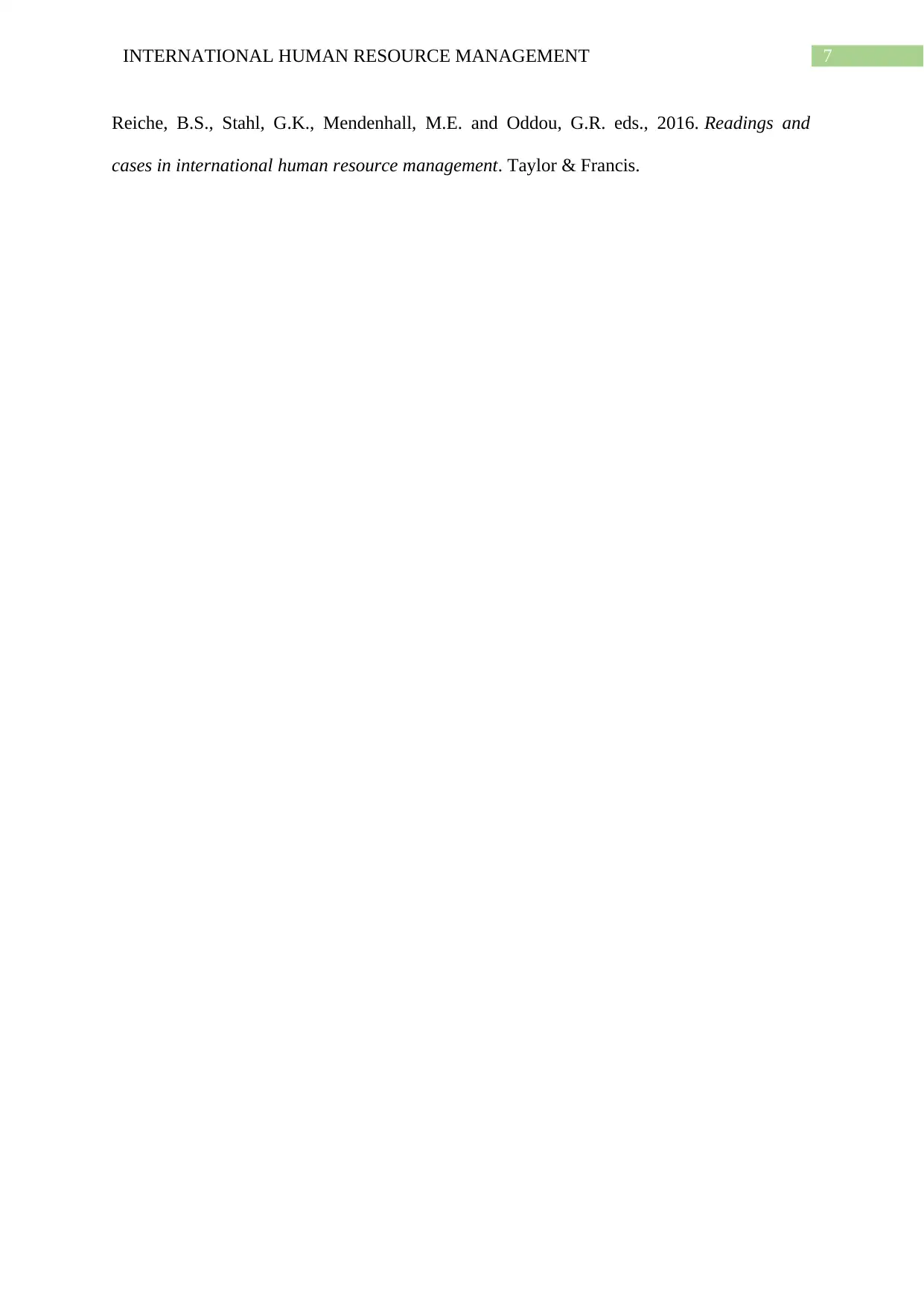
7INTERNATIONAL HUMAN RESOURCE MANAGEMENT
Reiche, B.S., Stahl, G.K., Mendenhall, M.E. and Oddou, G.R. eds., 2016. Readings and
cases in international human resource management. Taylor & Francis.
Reiche, B.S., Stahl, G.K., Mendenhall, M.E. and Oddou, G.R. eds., 2016. Readings and
cases in international human resource management. Taylor & Francis.
1 out of 8
Related Documents
Your All-in-One AI-Powered Toolkit for Academic Success.
+13062052269
info@desklib.com
Available 24*7 on WhatsApp / Email
![[object Object]](/_next/static/media/star-bottom.7253800d.svg)
Unlock your academic potential
Copyright © 2020–2025 A2Z Services. All Rights Reserved. Developed and managed by ZUCOL.





